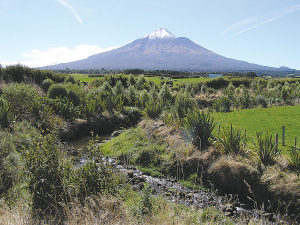Watermetrics appoints new sales engineer
Water data service provider Watermetrics has appointed Lee Hart as its sales engineer for lower Southland.
 The amount of nutrients, sediments and bacteria reaching a water body will depend on catchment features.
The amount of nutrients, sediments and bacteria reaching a water body will depend on catchment features.
Understanding the types of water features on your farm will help in making decisions to reduce the amount of contaminants reaching waterways.
A low point could be a lake, dam, river or the mouth of the river where it enters the ocean. A catchment also includes groundwater, storm water, wastewaters, and water-related infrastructure.
It is important to note that groundwater and surface water are also connected and may interact.
Surface water can reach ground water when it filters through soils to recharge groundwater.
Groundwater can reach surface water when solid rock layers prevent water infiltration downwards.
This creates shallow groundwater flows which can reach the surfaces as a spring. Groundwater can also reach surface water if the elevation of the groundwater next to a surface water body is higher than the water level in the stream.
This means that nutrients in groundwater have the potential to enter surface water and vice versa.
How different water bodies react to excess nutrients, sediment and bacteria.
The amount of nutrients, sediments and bacteria reaching a water body will depend on catchment features. These include land use and practices, rainfall amounts and patterns, soil types and slope, vegetation cover that intercept rainfall. Different types of water bodies react differently to excess nutrients, sediments and bacteria. Once in a water body the responses to nutrients (and sediments) differ between lakes and rivers.
Rivers
In a river, the flow determines the effect of excess nutrients on plant growth. The flow regime includes the volume of water, how fast the water is moving and when it flows. Rainfall is unevenly distributed across catchments and through seasons, so river flow is dynamic.
High Flows
During high flows, like floods, river water is often fast moving. These flows flush out sediments and nuisance plant growth.
The load may end up washed out to sea, deposited onto land or transferred into the next catchment. However, in catchments with lakes and estuaries, high flows can deposit surplus nutrients in these waterbodies that can cause issues at other times of the year.
Low Flows
During low flows, rivers water is often slow moving - such as dry summer periods or periods of demand for irrigation. The lower flow speed reduces the ability for the river to transport sediment and phosphorus, which can settle on the stream bed.
Problems that can occur under low flow include sediment build up and nuisance plant growth because flows cannot flush the channel. The lower water volume also concentrates nutrients, which poses greater environmental risk.
During low flows, nitrogen enriched groundwater can become the dominant source of flow in rivers increasing nitrogen concentrations.
Low flows can also reduce habitat availabilithy and increase temperature and oxygen stress on aquatic life.
Lakes
Lakes are especially vulnerable because rivers deposit nutrients or sediment loads in them where they accumulate over time.
Shallow Lakes>
Shallow lakes are snsitive to excess nutrients and sediments because wind and waves tend to stir up sediment more readily. This reduces clarity and shades out high value plants on the lake bottom, therefore resulting in loss of aquatic habitat for main species and a decline in water quality.
Article - DairyNZ
The Coalition Government will need the support of at least one opposition party to ratify the free trade deal with India.
Primary sector leaders have welcomed the announcement of a Free Trade Agreement between India and New Zealand.
At Pāmu’s Kepler Farm in Manapouri, mating has wrapped up at the across-breed Beef Progeny Test.
More than 150 people turned up at Parliament recently to celebrate the 20th anniversary of Horticulture New Zealand (HortNZ).
Biosecurity New Zealand says Kiwis should continue to keep an eye out for yellow-legged hornets (Vespa velutina) over the holiday season.
Fonterra has slashed another 50c off its milk price forecast as global milk flows shows no sign of easing.